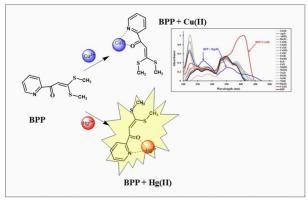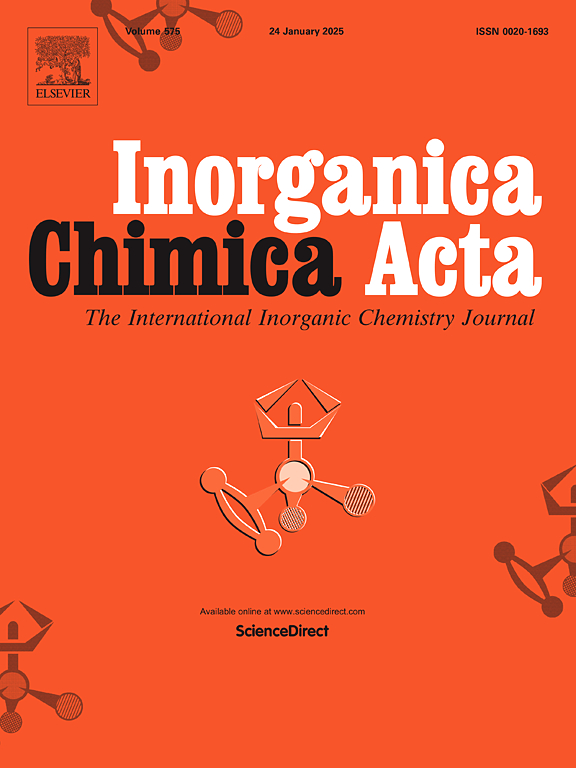基于吡啶-硫醚的选择性检测水中Cu2+和Hg2+离子的比色传感器
IF 3.2
3区 化学
Q2 CHEMISTRY, INORGANIC & NUCLEAR
引用次数: 0
摘要
合成了一种简单吡啶基比色受体3,3-二(甲基硫)-1-(吡啶-2-基)prop-2-en-1-one (BPP),并对其阳离子感知能力进行了研究。在紫外可见吸收研究中,受体BPP对Cu2+和Hg2+的选择性和灵敏度优于其他金属阳离子(Ag+、Al3+、Ba2+、Ca2+、Cd2+、Co2+、Cr3+、Cs+、Fe2+、Fe3+、K+、Li+、Mg2+、Mn2+、Na+、Ni2+、Pb2+、Sr2+和Zn2+),检测限分别为1.13 μM (Cu2+)和1.15 μM (Hg2+)。在比色学上,受体BPP仅在Hg2+存在下表现出从无色到暗黄色的选择性视觉颜色变化。将受体BPP应用于试纸条法和负载二氧化硅法检测Hg2+。本文章由计算机程序翻译,如有差异,请以英文原文为准。

A pyridine- Thioether based colorimetric sensor for selective detection of Cu2+ and Hg2+ ions in aqueous media
A simple pyridine based colorimetric receptor 3,3-bis(methylthio)-1-(pyridin-2-yl)prop-2-en-1-one (BPP) was synthesized and its cations sensing ability was investigated. In UV–Vis absorption study, the receptor BPP showed an excellent selectivity and sensitivity towards Cu2+ and Hg2+ over other tested metal cations (Ag+, Al3+, Ba2+, Ca2+, Cd2+, Co2+, Cr3+, Cs+, Fe2+, Fe3+, K+, Li+, Mg2+, Mn2+, Na+, Ni2+, Pb2+, Sr2+and Zn2+) with the detection limit down to 1.13 μM (Cu2+) and 1.15 μM (Hg2+). Colorimetrically, the receptor BPP showed a selective visual color change from colorless to dark yellow only in the presence of Hg2+. The receptor BPP was applied for the detection of Hg2+ by test paper strip and supported silica method.
求助全文
通过发布文献求助,成功后即可免费获取论文全文。
去求助
来源期刊

Inorganica Chimica Acta
化学-无机化学与核化学
CiteScore
6.00
自引率
3.60%
发文量
440
审稿时长
35 days
期刊介绍:
Inorganica Chimica Acta is an established international forum for all aspects of advanced Inorganic Chemistry. Original papers of high scientific level and interest are published in the form of Articles and Reviews.
Topics covered include:
• chemistry of the main group elements and the d- and f-block metals, including the synthesis, characterization and reactivity of coordination, organometallic, biomimetic, supramolecular coordination compounds, including associated computational studies;
• synthesis, physico-chemical properties, applications of molecule-based nano-scaled clusters and nanomaterials designed using the principles of coordination chemistry, as well as coordination polymers (CPs), metal-organic frameworks (MOFs), metal-organic polyhedra (MPOs);
• reaction mechanisms and physico-chemical investigations computational studies of metalloenzymes and their models;
• applications of inorganic compounds, metallodrugs and molecule-based materials.
Papers composed primarily of structural reports will typically not be considered for publication.
 求助内容:
求助内容: 应助结果提醒方式:
应助结果提醒方式:


